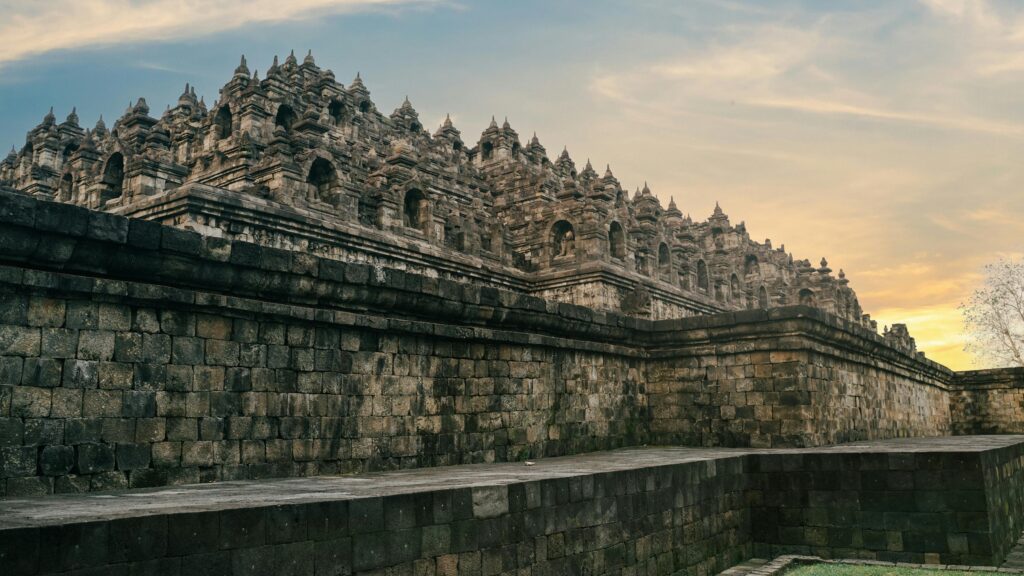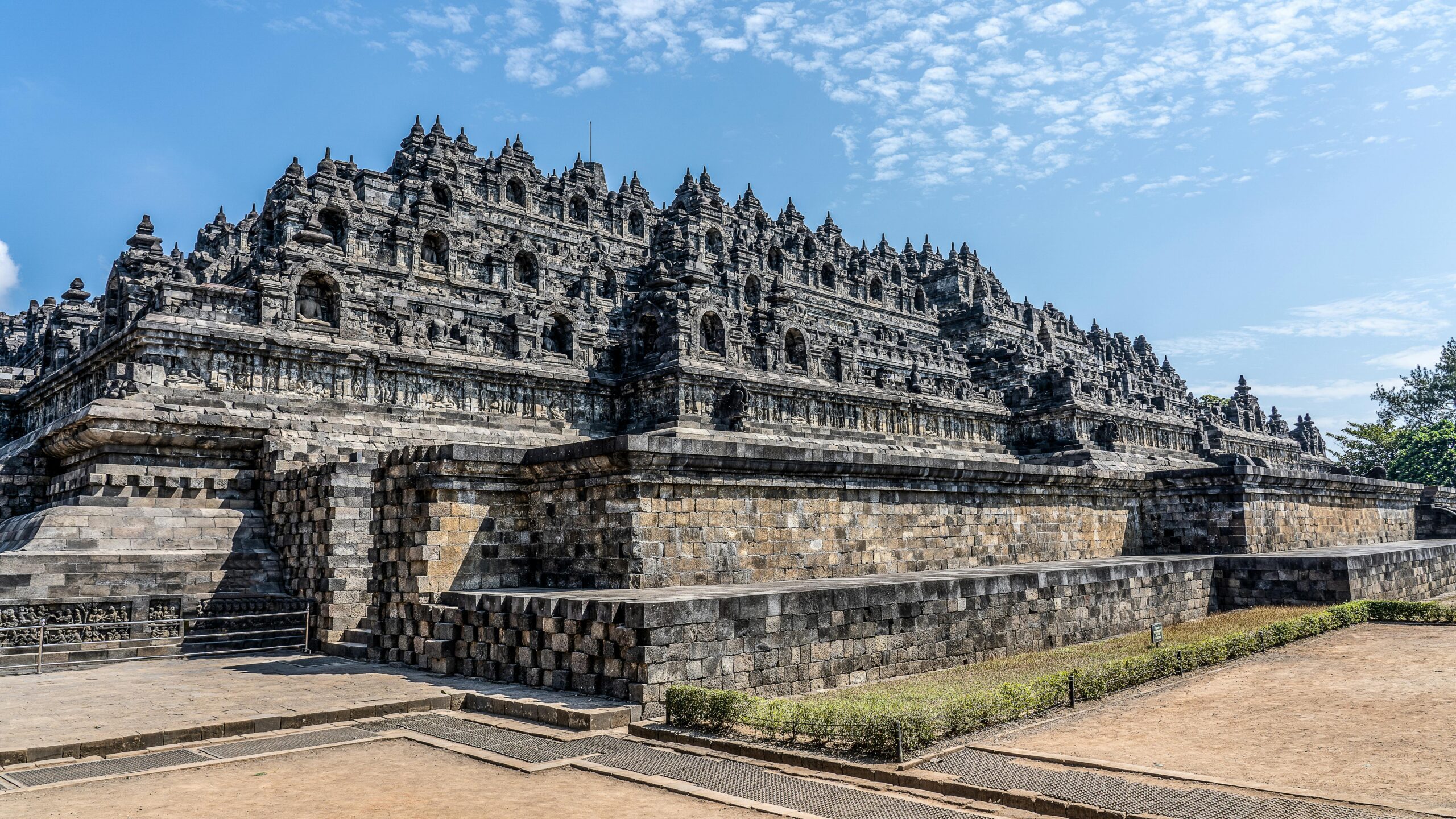Unveiling the wonder of Candi Borobudur
Nestled in the heart of Central Java, Indonesia, stands a colossal monument that transcends time -Candi Borobudur. This ancient temple, rising from the mists of Magelang’s lush valleys, is not merely a structure of stone but a profound testament to the human spirit’s devotion to enlightenment. With its terraces unfolding like a cosmic lotus, Borobudur whispers the stories of a civilization that sought harmony between heaven and earth.
Why Borobudur remains Indonesia’s crown jewel
Among the myriad cultural treasures of the archipelago, Borobudur reigns supreme. Its grandeur rivals that of the pyramids, yet its purpose is spiritual, not funerary. It is a living sanctuary that encapsulates Indonesia’s cultural identity, reflecting the nation’s role as a crossroads of ancient wisdom and artistic ingenuity.
A glimpse into the spiritual and historical significance
Borobudur is more than an architectural feat—it is a pilgrimage of the soul. Each level represents a step toward spiritual awakening, a symbolic ascent from the earthly realm to the divine. Over a thousand years after its creation, the monument continues to emanate serenity, drawing seekers and travelers into its quiet embrace.
The Origins of Candi Borobudur

Photo by Pexels / Free to use under license.
The mystery of its construction in Central Java
The origins of Borobudur remain shrouded in mystery. Built in the 8th–9th centuries, the temple emerged without written records detailing its creation. Archaeologists marvel at how such a massive structure—comprising over two million volcanic stones—was meticulously assembled in an era devoid of advanced machinery.
The Sailendra Dynasty: patrons of grand Buddhist architecture
Behind Borobudur’s magnificence stood the Sailendra Dynasty, rulers of Central Java who embraced Mahayana Buddhism. They envisioned Borobudur not as a place of worship, but as a cosmic diagram—a colossal mandala representing the universe itself. Their legacy endures in every intricate carving that adorns the temple’s walls.
Historical timeline: From creation to rediscovery
Completed around 825 CE, Borobudur was abandoned following the decline of the Sailendra Dynasty and the rise of Islam in Java. For centuries, it lay hidden under layers of volcanic ash and jungle overgrowth, until rediscovered in the early 19th century, awakening the world to its forgotten glory.
Architectural Marvels of Borobudur
The unique design: A mountain-shaped mandala
Borobudur’s design mirrors the sacred geometry of a mandala—its nine stacked platforms forming a cosmic mountain. The base represents the world of desire, the middle terraces symbolize form, and the circular top embodies formlessness—a visual journey from ignorance to enlightenment.
Layers of enlightenment: Understanding the three symbolic levels
The temple’s structure conveys Buddhist cosmology through three realms: Kamadhatu (the world of sensuality), Rupadhatu (the world of form), and Arupadhatu (the world of formlessness). Pilgrims circumambulate each tier clockwise, tracing the path toward ultimate awakening.
The stone carvings that tell ancient Buddhist tales
Adorning Borobudur’s walls are 2,672 relief panels—narratives of the Buddha’s life, Jataka tales, and moral parables. These exquisite carvings serve as a visual scripture, guiding visitors through the stages of spiritual growth with unmatched artistic detail.
Engineering genius: How ancient builders achieved perfection without modern tools
The builders’ precision remains an engineering enigma. Stones interlock seamlessly without mortar, forming a structure resilient to earthquakes and time. Drainage systems and subtle inclinations prevent water damage, showcasing the ancient Javanese mastery of both art and science.
Symbolism and Spiritual Philosophy
Borobudur as a spiritual journey toward Nirvana
Walking Borobudur’s terraces is akin to ascending a sacred mountain. Each level draws the pilgrim closer to the state of Nirvana—a realm of pure consciousness and liberation. The journey is both physical and metaphysical, guiding the soul toward inner illumination.
The meaning behind 2,672 relief panels
Every panel on Borobudur is a lesson. Some depict moral stories warning against worldly desire, while others portray acts of compassion and selflessness. Together, they form a grand philosophical tapestry that transforms stone into spiritual scripture.
The 504 Buddha statues and their symbolic hand gestures
Encircling the temple are 504 serene Buddha statues, each embodying a specific mudra, or hand gesture. These gestures—symbolizing meditation, teaching, and fearlessness—radiate universal messages of peace and balance.
Cosmic alignment and spiritual geometry in Borobudur’s layout
Borobudur’s alignment with Mount Merapi and other sacred sites is no coincidence. Its geometry reflects the Buddhist vision of cosmic order, aligning earth and sky, matter and spirit in perfect harmony.
Rediscovery and Restoration
The forgotten centuries: How Borobudur was lost under volcanic ash
For nearly a millennium, Borobudur lay silent, buried beneath volcanic debris from Mount Merapi. Local legends spoke of a “cursed mountain of statues,” shrouding it in myth until its rediscovery in the 1800s.
Sir Thomas Stamford Raffles and the rediscovery in the 19th century
In 1814, under British rule, Sir Thomas Stamford Raffles dispatched a team led by engineer H.C. Cornelius to investigate local tales. Their efforts unearthed a monument of astonishing scale, sparking worldwide fascination.
UNESCO’s massive restoration project: Bringing history back to life
By the 20th century, erosion and looting had taken their toll. In 1975, UNESCO and the Indonesian government launched an unprecedented restoration effort, dismantling and reassembling over one million stones. In 1991, Borobudur was inscribed as a UNESCO World Heritage Site—a triumph of cultural preservation.
Preservation challenges in the modern era
Today, the temple faces threats from environmental degradation and mass tourism. Conservation teams tirelessly monitor the site, balancing accessibility with preservation to ensure Borobudur endures for generations.
Cultural and Religious Significance
Borobudur as a center of Buddhist pilgrimage
Each year, thousands of pilgrims gather at Borobudur to commemorate Vesak Day, walking barefoot around the terraces in silent devotion. It remains a living testament to the continuity of Buddhist tradition in Indonesia.
Vesak Day celebrations: The light of faith and unity
During Vesak, the temple glows under thousands of lanterns, symbolizing enlightenment and compassion. The ritual unites people of all faiths, reaffirming Borobudur’s message of harmony and coexistence.
Blending of Hindu and Buddhist influences in Borobudur’s art
Though primarily Buddhist, Borobudur’s reliefs reveal subtle Hindu motifs—testament to Java’s syncretic spirituality. This fusion reflects the region’s openness to diverse philosophies, weaving unity through difference.
How local Javanese culture continues to embrace Borobudur
For nearby villagers, Borobudur is more than a monument—it is a living guardian. Local crafts, dances, and legends continue to draw inspiration from its timeless presence.
Legends and Myths Surrounding Borobudur
The tale of Gunadharma, the visionary architect
Legend credits the temple’s design to Gunadharma, a mystical sage who envisioned Borobudur in a dream. His spirit, locals say, still watches over the monument from a nearby hill.
Mystical beliefs and sacred energies around the temple
Many visitors report feeling an inexplicable calm upon entering Borobudur. It is said the temple sits on powerful ley lines, radiating spiritual energy that aligns the body and mind.
Local folklore that connects Borobudur with other ancient temples
Folktales suggest Borobudur, Mendut, and Pawon temples were built along a sacred axis, representing the cycle of birth, death, and rebirth—a symbolic triad of the Buddhist path.
Exploring Borobudur Today
Getting there: Travel routes from Yogyakarta and beyond
Borobudur lies about 40 kilometers from Yogyakarta, accessible by scenic road through emerald rice fields and volcanic vistas. Visitors can also join guided tours that unveil the region’s cultural treasures.
The best times to visit for breathtaking sunrise and sunset views
The magic of Borobudur is best witnessed at dawn when the sun rises behind Mount Merapi, bathing the temple in golden light. Sunset, too, offers a tranquil spectacle as shadows dance across the ancient stones.
Must-see highlights during your visit
Don’t miss the top circular platforms, where latticed stupas enclose serene Buddha statues gazing toward infinity. Each terrace reveals new stories, new sensations, and a deeper sense of awe.
Tips for sustainable and respectful tourism
Visitors are encouraged to tread lightly, refrain from climbing the stupas, and dress modestly. Respecting local customs ensures Borobudur remains a sanctuary, not a spectacle.
Nearby Attractions and Cultural Experiences
Mendut and Pawon Temples: The sacred triad of Borobudur
A short distance away lie Mendut and Pawon temples, forming a symbolic spiritual pathway to Borobudur. Each temple offers its own mystique and artistry, completing the ancient pilgrimage circuit.
Exploring Magelang’s hidden natural beauty
The region surrounding Borobudur teems with waterfalls, hot springs, and mountain trails—perfect for travelers seeking both nature and culture.
Local art, crafts, and batik traditions inspired by Borobudur
Artisans in nearby villages create exquisite batik, wood carvings, and stone replicas inspired by the temple’s reliefs—keeping centuries-old traditions alive.
Authentic Javanese cuisine and culinary experiences nearby
Indulge in local delicacies such as nasi megono and wedang uwuh—flavors that carry the warmth of Javanese hospitality.
Borobudur in Modern Indonesia
The temple as a symbol of national identity and pride
Borobudur stands as a proud emblem of Indonesia’s cultural renaissance—a monument that bridges the nation’s ancient past with its vibrant present.
Tourism and economic impact on local communities
Tourism sustains livelihoods across Magelang, fostering entrepreneurship and cultural pride. Yet, efforts are underway to ensure growth remains equitable and eco-conscious.
Educational programs and cultural initiatives around the site
Local foundations and schools collaborate on heritage education, ensuring younger generations understand Borobudur’s meaning beyond its grandeur.
How technology helps preserve Borobudur for future generations
Advanced 3D scanning and digital archiving now document every detail of the monument, safeguarding its form and spirit against time’s erosion.
Photography and Visual Splendor
Capturing the grandeur: Photography tips for visitors
Use soft morning light for detail-rich relief shots and wide lenses to capture Borobudur’s monumental scale. Respect quiet spaces where pilgrims meditate.
Iconic viewpoints for sunrise and drone shots
From Punthuk Setumbu Hill, one can behold the temple floating above the mist—a view that has graced countless travel magazines.
The play of light and shadow on Borobudur’s stone reliefs
As the sun moves, the reliefs come alive—faces illuminated, stories revealed. Light itself becomes an artist upon the temple’s canvas.
Borobudur in Global Recognition
A UNESCO World Heritage Site: What it means
UNESCO’s designation honors Borobudur as a universal treasure, safeguarding it as part of humanity’s shared heritage and reminding the world of its timeless wisdom.
Borobudur in art, literature, and popular culture
The temple has inspired poets, painters, and filmmakers worldwide, symbolizing the eternal quest for spiritual awakening.
International efforts to promote cultural exchange through Borobudur
Through global partnerships and exhibitions, Borobudur serves as a bridge of cultural understanding between East and West.
Spiritual Reflections and Life Lessons
Walking the Borobudur terraces as a meditative experience
Each step around Borobudur’s tiers is a meditation—a rhythmic journey of stillness and self-awareness, echoing the pilgrim’s inner ascent.
Lessons in impermanence, mindfulness, and peace
Borobudur teaches impermanence. The carvings erode, yet their essence endures, reminding humanity that beauty lies in transience and harmony.
The universal message of Borobudur’s carvings
The reliefs whisper an eternal truth: compassion is the highest form of wisdom, and peace begins within.
Environmental and Preservation Efforts
Managing mass tourism while preserving sacred heritage
Visitor limits, guided paths, and local awareness campaigns aim to protect Borobudur’s fragile stones from overuse and neglect.
Climate change and its impact on the monument
Rising humidity and acid rain threaten the integrity of the stone. Continuous research seeks sustainable ways to counter environmental decay.
Local community involvement in conservation projects
Villagers participate in conservation and eco-tourism programs, ensuring that Borobudur’s protection benefits both heritage and humanity.
Future of Borobudur
Sustainable tourism initiatives for long-term protection
Authorities envision Borobudur as a model of responsible tourism—where reverence outweighs recreation.
Digital mapping and 3D preservation technologies
Cutting-edge imaging ensures that every stone, relief, and Buddha face is immortalized digitally for future generations to study and admire.
The vision for Borobudur as a global center of peace and learning
Plans are underway to transform the surrounding area into a hub for intercultural dialogue, meditation, and environmental education—a living testament to harmony.
Conclusion
Why Borobudur remains timeless and transcendent
Borobudur defies time. Its stones breathe wisdom, its form radiates balance. It stands as a silent teacher, reminding humanity of its shared spiritual roots.
The enduring message of harmony between humanity and the divine
Through its symmetry, symbolism, and serenity, Borobudur speaks of a universal truth—that enlightenment is not distant, but within.
A call to preserve and cherish Indonesia’s most sacred wonder
As the sun rises once more over Central Java, Borobudur continues to awaken hearts across the world. Its call is clear: protect, respect, and remember.




